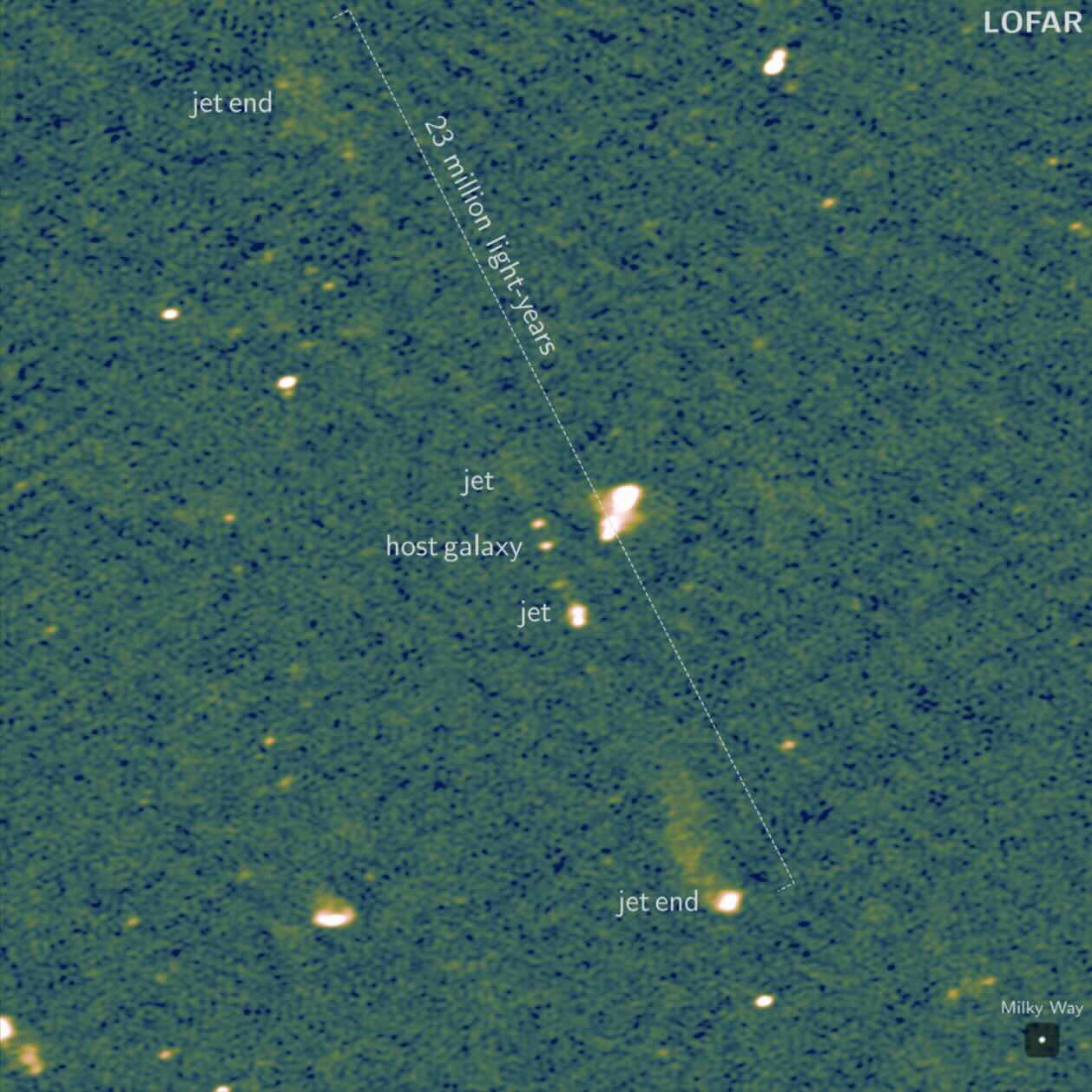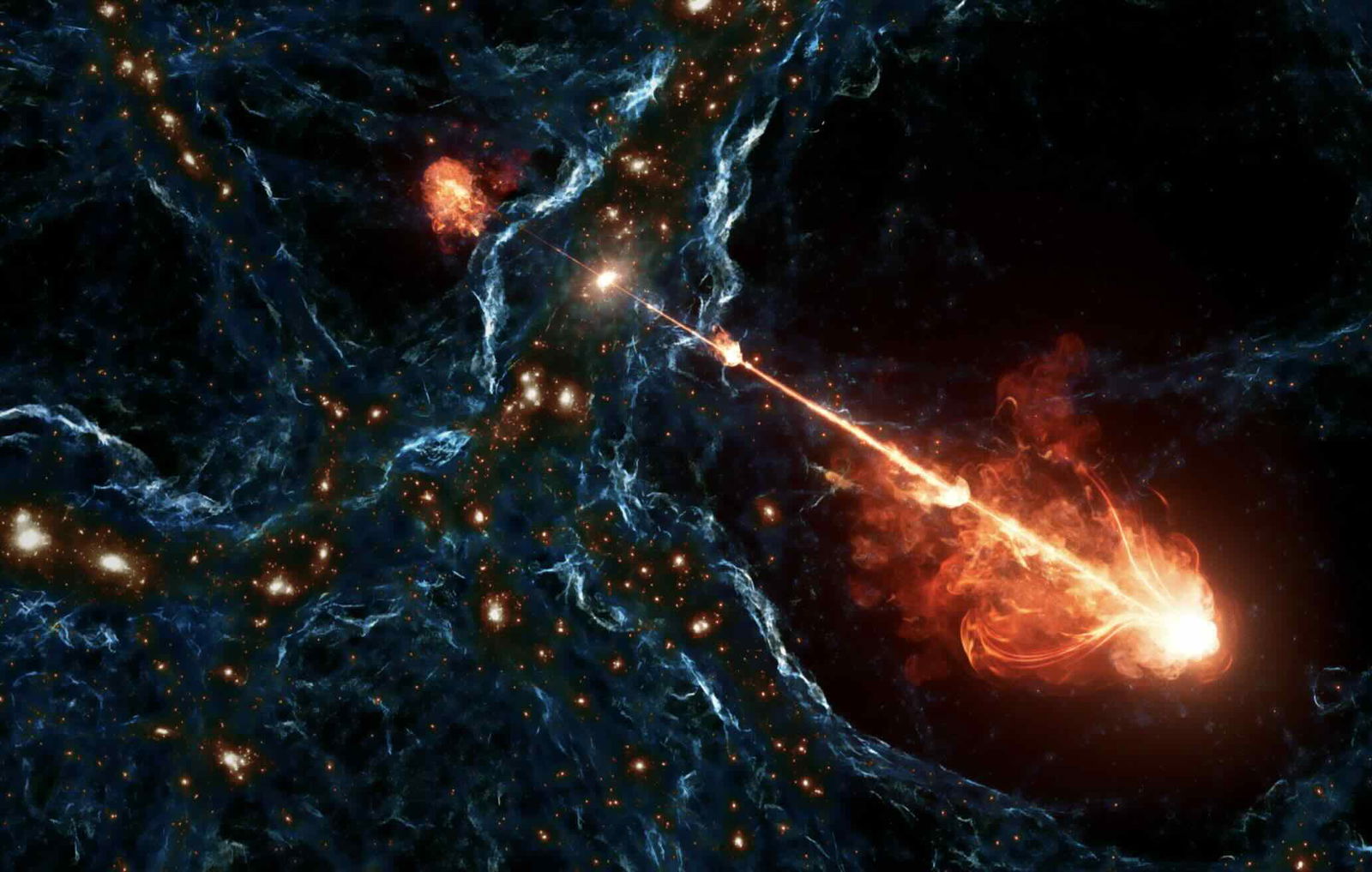In a breakthrough discovery, astronomers report the detection of the largest pair of black hole jets ever observed, which span an incredible distance of 23 million light years.
According to researchers involved with the groundbreaking new findings, the immense megastructure, dubbed Porphyrion, is roughly the size of 140 Milky Way galaxies.
The discovery of these vast outflows, capable of producing enough energy to match trillions of Earth’s suns, offers an unprecedented showcase for the power and reach of black hole jets from a galaxy when the universe was only 6.3 billion years old.
The research was led by Martijn Oei, a postdoctoral scholar at Caltech, and suggests that massive jets like Porphyrion could have a far more significant influence on galactic formation than previously known.
Porphyrion: A Cosmic Giant Unrivaled in Size
Vastly outsizing any previously recorded cosmic megastructure of its kind, Porphyrion’s jet system is the largest known. Its discovery follows an earlier detection by Oei and his team in 2022, which involved the discovery of Alcyoneus, previously the largest known black hole jet system with a size equivalent to about 100 Milky Ways.


By comparison, the closest major jet system to Earth, Centaurus A, is only ten Milky Way diameters in size. Oei and his team believe that when Porphyrion formed, the network of filaments between galaxies was far more dense. This indicates that they may have reached across vast regions of space, potentially affecting the formation of galaxies across large swaths of the universe.
Before Oei and his team’s recent discovery, massive jets like those produced by Porphyrion, a radiative-mode active black hole, were considered a relatively recent phenomenon in the cosmos.
“Up to now, giant jets have been seen mostly in the more recent or ’nearby’ Universe,” Oei explained in an email to The Debrief. “In the nearby Universe, most active black holes are of the ‘jet-mode’ type: of all the energy they send off to the outer parts of their galaxy (and beyond), most is in the form of jets.”
Oei emphasized that jet-mode active black holes differ from other varieties in that they lack the accretion disks popularly associated with artistic concept imagery of black holes that can be found online, adding that past associations of massive jets with jet-mode active black holes may have been incorrect, and possibly arose resulting from biases in past observations.


“As we are building more sensitive instruments, as we have done with the International LOFAR Telescope over the last two decades or so, we are starting to see giant jet systems in the more distant Universe,” Oei told The Debrief. “Porphyrion is one such example.”
Oei also said his team discovered a few surprises along with the detection of Porphyrion and its massive black hole jets: in particular, this massive structure comes from what astrophysicists call a radiative mode black hole.
“Radiative-mode black holes are much more common in the young Universe than they are now, and are likely to dominate the population of active black holes,” Oei told The Debrief, emphasizing that this discovery could point to the reality that gigantic jets may be as frequently associated with this variety of black holes as others, a discovery that challenges previous thinking on the matter.
“Our study suggests that radiative-mode active black holes might be as capable of generating giant jets as jet-mode active black holes are in the nearby Universe,” Oei said. “If true, there could be many more ‘Porphyrions’ in the young Universe!”
Oei says that Porphyrion has a significant impact on the surrounding cosmic web, mainly due to the fact that the intergalactic medium surrounding it is heated by close to a million degrees, activity that also very likely magnetizes the local environment.
“If giant outflows such as Porphyrion occurred routinely in the past when the cosmic web was more compact, then giant jets might have had a big cosmological role to play that has been hitherto neglected,” Oei told The Debrief. “One such cosmological role could have been the spread of magnetism through the cosmos.”
A Window into the Young Universe
George Djorgovski, a professor of astronomy at Caltech and co-author of the study along with Oei, says the impact of such giant jet systems is significant because current theories link the evolution of galaxies to their central black holes, a key aspect of which is the dispersal of energy by black hole jets.
Djorgovski says the discovery of Porphyrion “shows that their effects can extend much farther out than we thought.”
The team’s new findings are part of an ongoing survey being undertaken with Europe’s LOFAR (Low-Frequency Array) radio telescope. This telescope has already successfully discovered more than 10,000 faint megastructures, increasing the number of such features previously known from just a few hundred large jet systems.


The survey’s result thus far, assisted by the combined capabilities of LOFAR’s wide field of view and its sensitivity to extended cosmic structures, is a vast and previously unknown population of giant jets throughout the universe, all of them currently dwarfed by the immensity of Porphyrion.
The latest batch of findings, now detailing more than 8,000 jet pairs, is set to be published in Astronomy & Astrophysics.
Surprising Discoveries and New Mysteries
Although large-scale black hole jets had been known to astrophysicists previously, the number of these objects discovered by LOFAR had not been anticipated.
Additionally, the team’s findings are helping to shed light on how long-lived and stable accretion events around supermassive black holes may influence the direction and longevity of black hole jets and the kinds of factors that may contribute to their ability to maintain this stability over long periods.
“We think the jets in these systems in general are driven by accretion events,” said Martin Hardcastle, a professor of astrophysics at the University of Hertfordshire and second author of the study, in an email to The Debrief.
“So to generate a very long-lived jet like this one you need long-lived accretion, which must provide quite a lot of power to keep the jet going for the lifetime of about 1 billion years that we get from our models,” Hardcastle said. “We also need the jet axis not to change over that time, which basically means that the spin axis of the black hole cannot have altered over the lifetime of the jet source,” he added.
So, how did the source remain unaltered in this way for so long? In Porphyrion’s case, Hardcastle says it may have simply been luck.
“Our guess is that this source just ‘got lucky’ in that it was hosted by a very quiescent galaxy with no galaxy or black hole mergers to disrupt the activity of the center black hole over all of that time,” Hardcastle told The Debrief. “The rarity of these very large objects may just be a matter of the very low probability of getting such a benign environment for jet growth.”
Looking Forward: How Massive Black Hole Jets Shape the Universe
The discovery of Porphyrion raises new questions about how these jets affect their environments. Black hole jets are already known to spread cosmic rays, heat, and heavy elements throughout the universe. For Oei, another significant interest involves how they contribute to the spread of magnetism throughout the cosmic web, a process that may contribute to the formation of magnetic fields within galaxies, stars, and planets.
“We know that black hole jets are magnetized, because it is the magnetic field of the jets that keeps the high-speed particles (mainly electrons and positrons) in them collimated,” Oei told The Debrief. “Where jets are finally destabilized and thus demolished, a big plasma cloud remains.”
Oei says that observations of “lobes” of plasma that result from the destruction of jets show that they are strongly magnetized, possessing field strengths much higher than those found in the cosmic web.
“Astronomers believe that the magnetic field in the cosmic web made its way into galaxies, from galaxies into star-forming clouds, and from young stars into the proto-planetary disks from which planets eventually emerged,” Oei says.
“Magnetic fields around planets shield their atmospheres from erosion by stellar winds. It’s important to point out that these magnetic fields have been much amplified since the time they inhabited the cosmic web, but the seed field of the magnetic fields around us today is the magnetic field of the cosmic web.”
Oei told The Debrief that, until recently, the apparent rarity of giant black hole jets had prevented him and his colleagues from considering whether they might have been the driving force behind the formation of the cosmic seed field from which modern magnetic fields arose.
“That is why I now want to investigate in more detail whether, and precisely how, giant jets produced the cosmic seed fields,” Oei said.
Going forward, the team plans to continue surveying the sky using LOFAR. Based on their current findings, they remain confident that many more colossal jet systems remain hidden in the far reaches of the universe, awaiting eventual discovery.
Oei and his team’s new paper, “Black hole jets on the scale of the cosmic web,” appeared in Nature on September 18, 2024.
Micah Hanks is the Editor-in-Chief and Co-Founder of The Debrief. He can be reached by email at micah@thedebrief.org. Follow his work at micahhanks.com and on X: @MicahHanks.

